Tales from the Archive: Draper's Hall - A Building through Time
08 November 2019
On 8th November 1832 Draper's Hall was opened with a celebratory ball but the building has changed a lot from its original design.
Paramjit from Coventry Archives explores Draper's Hall's long architectural history.
Draper’s Hall is situated on Bayley’s Lane, next to Coventry Cathedral and the Herbert Museum and Art Gallery – in fact the building is visible from the Coventry Archives.
The Draper’s Company, who specialised in trading textiles, commissioned the building as a social hall. It was designed with activity rooms and offices, as well as a large Ballroom which could house an orchestra for Dancing Assemblies.
The original design for Draper’s Hall was built in 1637 and was described by historian Thomas Sharp as ‘a dark gloomy edifice’. Whilst Sharp does not further describe the architecture of this initial build, it may have fallen under the baroque designs of the 1600s with an overbearing ostentatious style. Perhaps because of its unappealing aesthetic appearance, the building was taken down in 1775 and replaced with a new design.
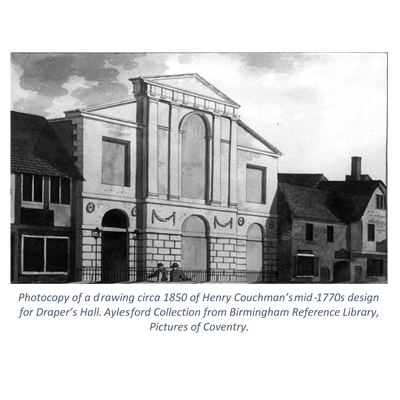
This second design was conceived by an architect called Henry Couchman and the building now followed a simple stone façade with Tuscan pilasters. Sharp described this version of Draper’s Hall more favourably, admiring the large ballroom measuring 49 x 25 feet and commenting on its overall ‘simple elegance’.
However, this building was condemned in 1829 due to the rapid spread of dry rot amongst the key wooden beams. Thus, architects Messrs Thomas Rickman and H.W. Hutchinson from Birmingham were employed by the Draper’s Company to design a new Hall.
The removal of the old condemned structure began in 1830 and within two years the new building was complete. It has been described as abiding by a Grecian style of architecture; it had four ionic columns on the portico as well as antae, which are pilasters that are placed on the end of a side wall. There was also an upper cornice above the portico, decorated with the Draper Company Coat of Arms.
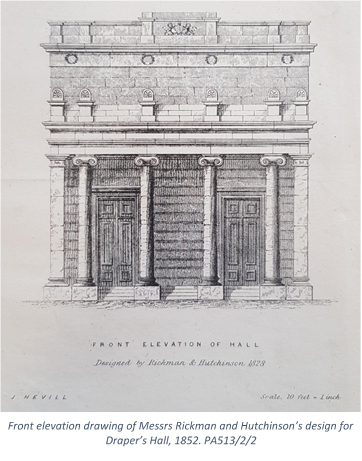
To celebrate the opening of this exquisite building, a supper and ball was held at Draper’s Hall on 8th November 1832. Guests would have walked through the two front doors, up a short flight of stone stairs which then connected to the corridor. From here, the first room was the 20 foot square Card Room, followed by the 40 foot long Tea Room and finally the Ballroom which measured 60 by 30 feet. The latter had decorative pilasters and a large metal skylight which Sharp described as following a ‘chaste and elegant design’. The orchestra would have been placed at the side of the room, giving people plenty of space to perform popular European dances.
Much of this design by Rickman and Hutchinson remains today, such as the portico, decorative cornice and, by and large, the interior layout. However, some key alterations which occurred over the years included the addition of an East Wing in 1864 which gave the façade the curved appearance which it currently retains. The below plan illustrates these additions:
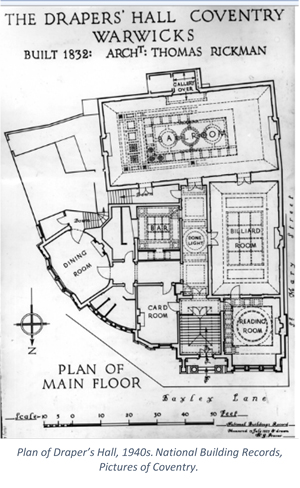
Also, this plan shows a key change to the portico which drastically altered the façade of the Draper’s Hall. In 1890, architect E. Burgess removed two pillars from the right-hand side of the portico and extended the building forward. This allowed for a window to be inserted, letting in more natural light to the Reading Room. This was a necessary addition because, due to the other buildings initially surrounding Draper’s Hall (which were later removed between1851 and 1886), there were no side windows on the building. This meant that all natural light entered solely through skylights and domes.
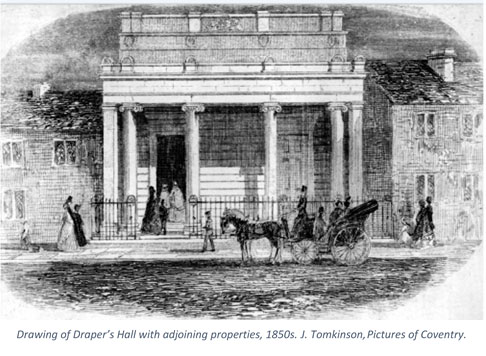
It could be argued that Burgess’s alteration removed the building’s design from its intended Grecian appearance and symmetrical aesthetic. However, the decorative pilasters are still in keeping with more contemporary neoclassical designs. Moreover, Burgess’ intervention included installing a new heating system and a ballroom lantern skylight. Further to this, there was also the addition of a large Dining Room circa 1890.
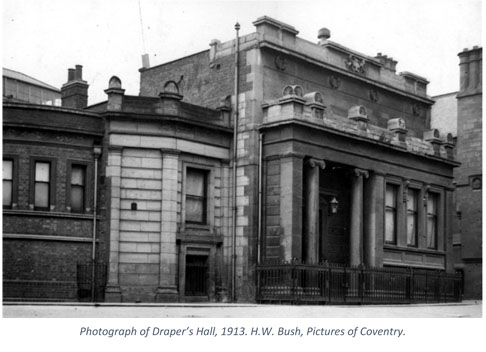
Much later in August 1939, Draper’s Hall was obtained under the Civil Defence Act in order to convert the basement into a public air raid shelter during the Second World War. There is documentation of the correspondence over the purchase of this premises at the Coventry Archives. Firstly, the Port family who occupied Draper’s Hall requested that the wine cellar would not be made accessible to the public due to the expensive wines stored there. However, the government did not agree to this, instead stating that all damages would be compensated after the war. The overall compensation equated to £13. 3s. 6d (roughly £518.39 in today’s money) and was paid in March 1940.
A longer standing issue was caused over the Women’s Voluntary Service who occupied the Ballroom and Reading Room at Draper’s Hall. Despite not being part of the original agreement, the WVS used the building as their headquarters between 1939 and 1949, much to the annoyance of the Company’s members. However, this proves that Draper’s Hall was a pivotal building in the heart of Coventry, which allowed the WVS to help civilians through distributing clothes and giving health treatments even after the Second World War ended.
Therefore, Draper’s Hall can be seen as a building with great architectural history. Through its many iterations it has managed to stay intertwined with the social developments within Coventry; since being utilised solely as the Draper Company social hall, to becoming a vital beacon for the public during war. The endurance of this building truly exemplifies the renewal of the city of Coventry.
Glossary:
Baroque – A European style of art, music, design and architecture spanning the 17th and 18th centuries. In architecture it is identifiable by its opulent decorative appearance which often included oval spaces, domes, twisting columns, sculpted frames and elaborate staircases.
Column – A cylindrical pillar which acts as an architectural support for a structure. Columns can follow different styles in accordance to various architectural orders (i.e. Doric, Ionic, and Corinthian).
Cornice – An ornamental moulding on a building, near the interior or exterior ceiling space.
Ionic – This term relates to a specific type of architectural order described by Ancient Roman architect Vitruvius. Out of the orders Doric, Ionic, and Corinthian, which are distinguished by different ratios and purposes, Ionic columns are identifiable by their scrolled capital ornamentation. This order was originally deemed suitable for temples devoted to feminine goddesses.
Pilaster – A rectangular-looking column which is connected to a wall. As opposed to columns, pilasters are often largely decorative rather than being key architectural supports.
Portico – A structure attached to the porch of a building, usually with a roof and columns supporting it.
Sources:
Publications: Thomas Sharp, History of Coventry, Coventry, 1844; David McGrory, A History of Coventry, Chichester, 2003 (Both books are available in the Herbert Museum and Art Gallery, History Centre, Reading Room).
Archive items: File relating to public air raid shelters (CCA/3/1/9895); Description and Plans of Property in Coventry and Stoke (PA 513/2/2); Pictures of Coventry images; Pamphlets for Draper’s Hall JN725.1343.